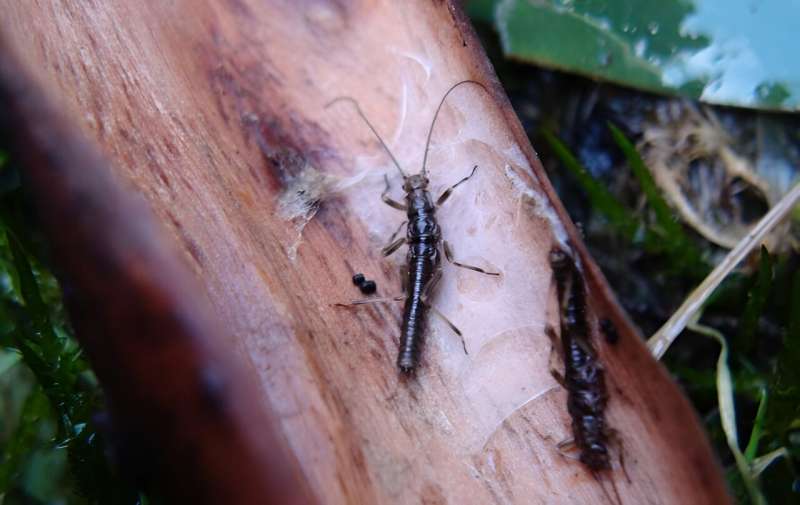This article has been reviewed according to Science X's editorial process and policies. Editors have highlighted the following attributes while ensuring the content's credibility:
fact-checked
trusted source
proofread
Victoria's new habitat law fails to protect a tiny endangered species, say researchers

Australia's unique and diverse wildlife is a source of national pride and global fascination. But this reputation is marred by our country's alarming rate of species extinction.
Australia has already earned the dubious title of the world leader in mammal extinction—and invertebrate (animals such as spiders, worms, snails, lobsters, crabs and insects) extinctions are likely to follow.
In the state of Victoria, the Critical Habitat Determination, which sits under the Flora and Fauna Guarantee Act, is a key conservation tool that has never been applied.
It aims to safeguard critical habitat for threatened species when no other laws afford adequate protection and the distribution of a particular species is uncertain.
So the recent decision by the Department of Energy, Environment and Climate Action (DEECA) to go against the advice of the Scientific Advisory Committee and not extend any protection to the critically endangered Mount Donna Buang Stonefly (Riekoperla darlingtoni) has potentially dire consequences for this species and others.
According to reports, DEECA has yet to comment publicly.
The stonefly, one of only three wingless stonefly species in Australia, lives in alpine regions above 800 meters, thriving in small streams fed by spring rains and snowmelt.
The adult Mount Donna Buang Wingless Stonefly is brown and about 12 millimeters in length with dark markings on its thorax. The nymph—the sub-adult aquatic stage—grows in water and is smaller with a terminal gill tuft.
Uniquely adapted to cold conditions, the adult stonefly emerges at below zero temperatures, something not found in any other Australian stoneflies.
In 2013, the International Union for Conservation of Nature (IUCN) recognized its "critically endangered" status and in 2022, it highlighted this tiny insect's significance as one of 50 landmark freshwater species for conservation globally.
Although the species may not be as famous as some of Australia's other endangered animals like the earless dragon or the Bogong moth, it is a crucial part of our biological heritage. And it's in trouble.
Since 2006, its main population has dropped by more than 90%, a situation likely made worse by climate change-induced warmer weather as well as reduced rainfall and snow cover.
However, the Mount Donna Buang Stonefly is still not listed under the federal Environment Protection and Biodiversity Conservation Act (EPBC Act).
Without this, there's no access to enhanced protection or resources for an adequate survey and development of a recovery plan.
And without a Critical Habitat Determination, protection is limited only to a very small area around Mount Donna Buang in the Victorian Alps.
But in fact, the actual range of the species could be larger, given other potential suitable areas of habitat above 800 meters of altitude and with seasonal alpine springs.
Having a Critical Habitat Determination is an efficient mechanism to ensure care is taken with any commercial developments, and management activities that include road grading, trail maintenance, weed spray, firebreak logging, control burns and the like.
The lack of a Critical Habitat Determination in this case was based on the fact that the species lives in a national park—in Australia, this is an area of land protected because of its unspoiled landscape, outstanding or representative ecosystem.
It was also based on the fact that a proposed mountain bike trail wouldn't be built close to a known site where the stonefly lives.
But while residency in a national park offers some safeguards, developments like the mountain bike trail do occur.
Without formal recognition under the EPBC Act or a Critical Habitat Determination—the stonefly remains on the brink of extinction.
It's concerning that the advice of the Scientific Advisory Committee was not followed, given the often-repeated principle of "science informs management" and the precautionary principle of biodiversity conservation.
It also suggests gaps in the Critical Habitat Determination framework.
Unfortunately, the list of species in need of protection in Australia is growing and protection of our natural heritage remains a problem.
For example, Victoria's latest State of the Environment Report tells us that only five out of the 13 goals of the five-year Threatened Species Strategy were met by 2020.
By the government's own assessment, our biodiversity management, particularly the management of threatened species and ecological communities, remains poor.
When it comes to invertebrates, only 35% of the estimated 320,465 invertebrate species in Australia have been formally identified. And only one-tenth of 1% of these species have been listed as threatened.
All of this means that Australia clearly doesn't know how much invertebrate biodiversity we have and how much we risk losing. So much more investment is needed to catalogue our species diversity accurately.
Meanwhile, efforts aimed at conserving the Mount Donna Buang Stonefly are not just about saving individual species. Other species, some likely yet to be identified, will also benefit.
In the 21st century, it's time to ensure that future generations of humans and animals inherit a rich and diverse landscape that includes a small but important wingless stonefly.
Provided by University of Melbourne



















